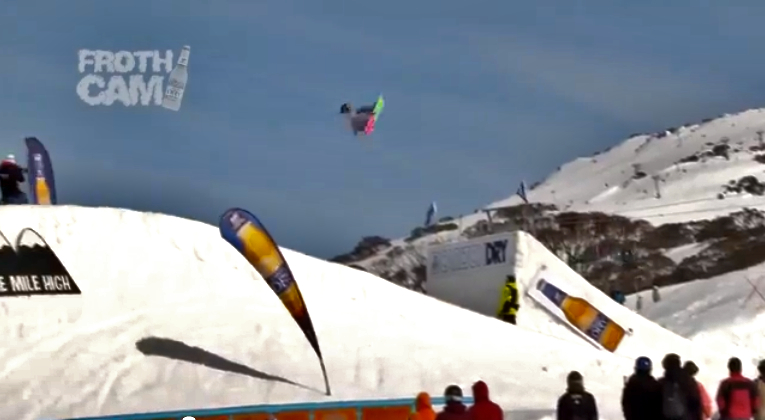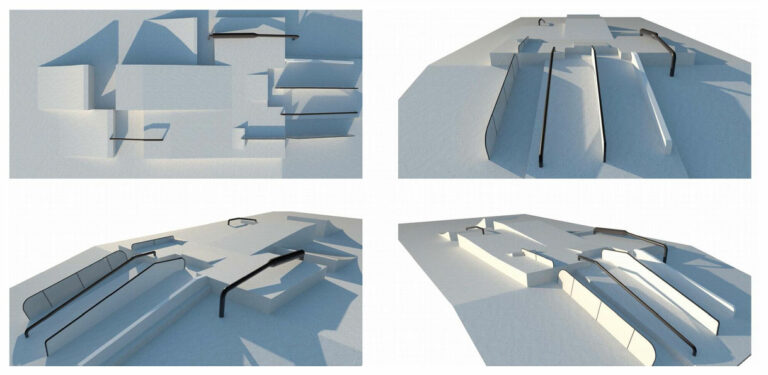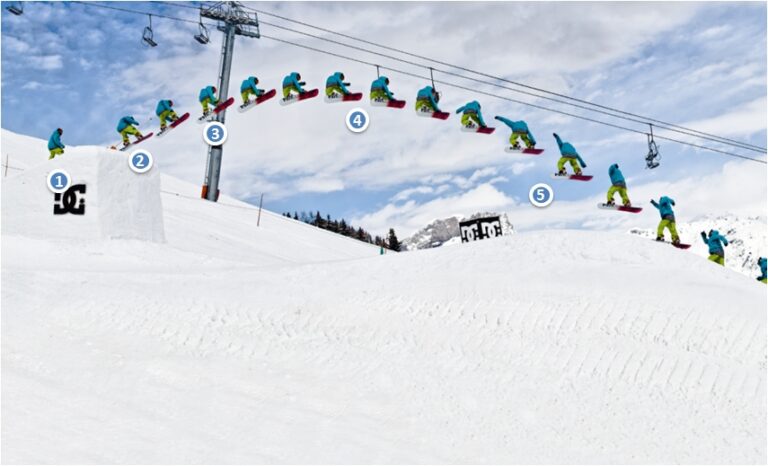A couple weeks back we stumbled across Pivit bindings – a bizarre prototype binding system that allow your feet to hinge on your snowboard laterally for maximum tweakability.
Here’s a shot of inventor Christopher Scott Hassell poking the shit out of a melon on ’em:
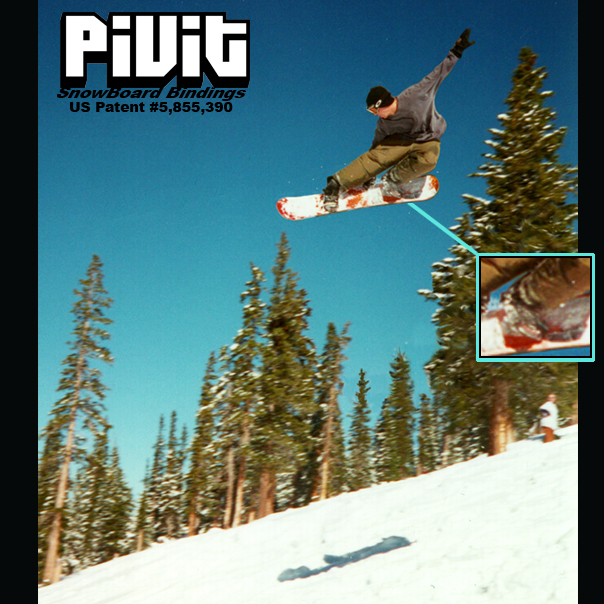
As you’d expect, the article stirred up some healthy debate on our Facebook page with a whopping 56 comments ranging from those strongly against the idea:
Worst idea ever.. aside from those weird dual snowboard things…
…skis…?
to those embracing it:
My tuck knees would be so gnar.
to those downright confused…
Is that picture of a dude snowboarding on his bed?
As you also might have expected, judging on the responses to other unusual takes on binding design that we’ve seen recently (these weird rotating ones spring to mind), the majority of the comments were rather critical.
So, in an attempt to get a different perspective on this particular creation we fired some questions over to inventor Christopher Scott Hassell:
1. What inspired you to create the Pivit binding?
Many years of skateboarding. I grew up an avid skateboarder. It’s pretty much all I did in middle school and high school. I skated vert, mini ramp and/or street everyday. I lived on the east coast in Suffolk, Virginia and there was not much snow. The few times it did snow we took the trucks and wheels off our boards, grabbed one of moms candles for wax, flipped the front two truck bolts upside down to catch our front foot and went “snow skating or snow skimming” on local hills.
(I also skim boarded at the beach which was similar: toss board, run, jump and slide.)
Those few glorious days a year were so fun and memorable that I became consumed with the thought of real snowboarding. I dreamt of moving to Colorado for real snow & real mountain experience. Several years later that’s exactly what I did. I moved to Colorado and spent multiple seasons living in Eldora, Breckenridge, Vail, Beaver creek and Winter Park.
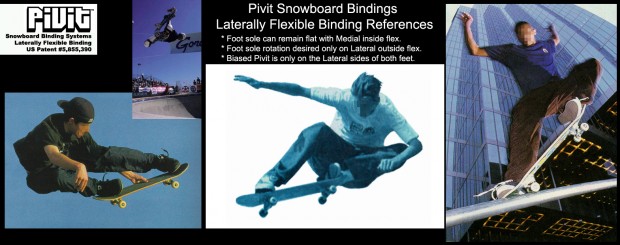
From my very first season I never liked the feel of my feet being locked down flat to the board while in the air. The way the soles of my feet were shackled flat to the board kept me from contorting my airs. I felt I had these “movement stoppers” called bindings on my feet and that really irritated me. It felt terribly restrictive when doing freestyle. It held me back from positioning my body the way I wanted to on my board. My tweak style was decent but to me it paled in comparison to the same look and feel of fully tweaked out grabs that I did on my skateboard. I wanted my aerial freedom of body movement on the snowboard and I wanted to tweak exactly like one could on a skateboard, not just close enough but almost exactly, like fully contorted. That was my desire. So that inspired me to start designing and building my own binding prototypes, just for me, so I could improve my personal snow style and gain more freedom of movement in the air.
2. How do you think Pivit bindings will change the way people snowboard?
I think people riding them can snowboard the same way but with the added benefits of much more freedom of body and leg movement in relation to the board. For me they just feel better, like a much more natural connection to my board. I personally enjoy the added range of motion and freedom my legs have. The binding is a simple, efficient and successful design for what I set out to achieve. Having this ability to do more expressive or tweaked out aerials & tricks without that feel of one’s feet being limited and stuck flat to the longitudinal plane of the board does open up style and trick options.
3. What are the advantages of the Pivit system?
A more natural feel in a solid foot to board connection. More flexibility and greater freedom of body, legs and feet movement in a binding system that still handles as desired on snow. The ability to lock and unlock this lateral flex pivot feature if desired with the push of a button. All in a solid, simple, effective and most practical design.
There’s also an element of safety that can be advantageous. One study showed a high number of snowboarding injuries involved ankles, primarily as sprains and strains, which refers to damage of the muscles, ligaments and or tendons as a result of being pulled or stretched too far. The extreme forces and tension that can pull an ankle too far can be released with the Pivit binding system which can save ankles from injury.
For example, Imagine a person standing in a snowboard stance with their bare feet cemented flat to the floor. Then someone swiftly pushes this person down onto their right side. They fall laterally and their right knee and hip hit the floor. Due to our body mechanics the right ankle may likely get injured and the left ankle will not be harmed. (The opposite will happen if pushed down to the left side). In certain situations a similar effect can happen in snowboarding with traditional bindings that hold the entire sole of the foot flat to the board.
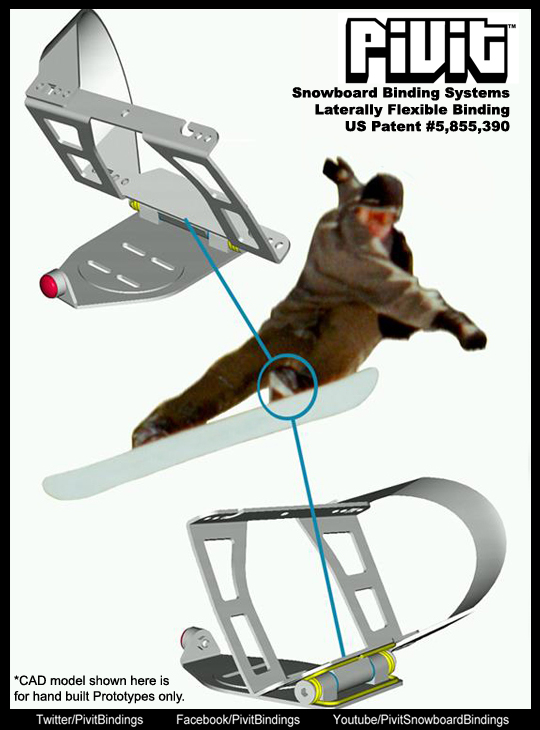 With my binding designs injury causing force/pressure/tension can be released from the ankle by allowing the foot to safely roll off the “floor” as needed while still maintaing the same position and directional orientation on the floor. The foot can pivot on it’s outside edge (pinky toe side) which is still touching the floor in the same location, but the rest of the sole of the foot is allowed to lift as little or as much as needed to avoid over extension and possible ankle injury.
With my binding designs injury causing force/pressure/tension can be released from the ankle by allowing the foot to safely roll off the “floor” as needed while still maintaing the same position and directional orientation on the floor. The foot can pivot on it’s outside edge (pinky toe side) which is still touching the floor in the same location, but the rest of the sole of the foot is allowed to lift as little or as much as needed to avoid over extension and possible ankle injury.
4. When might we see Pivit bindings on sale?
Right now Pivit bindings is just me. I’m the inventor, designer, hand fabricator and rider-tester. I have more orders than I am currently fulfilling and interest is constantly growing. I get contacted by more riders each week who get it and want a pair. It really depends on the deal I get. The amount of support and funding I receive will directly impact the timeline, global reach and availability of the bindings. There is growing interest from several shops as well as the snowboarders and Snowflex riders. I am ready and prepared to put my newest designs( still not shown to the public) on snow and in shops this coming season. With outside funding and support this can happen on a large scale rather quickly. Without good funding and support I’ll just keep doing my own thing and it may be awhile before you see or ride them.
Do this change your opinion on Pivit bindings? Could there be space for something like this on the market or do you think they’d still be more annoying than not to ride? Let us know below!

